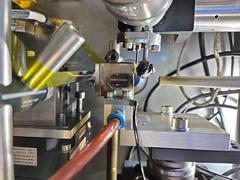URL: https://www.desy.de/news/news_search/index_eng.html
Breadcrumb Navigation
DESY News: Artificial intelligence improves control of powerful plasma accelerators
News
News from the DESY research centre
Artificial intelligence improves control of powerful plasma accelerators
An international team of accelerator experts with participation of researchers from DESY has successfully demonstrated that an algorithm was able to tune the complex parameters involved in controlling the next generation of plasma accelerators. The algorithm was able to optimize the accelerator much more quickly than a human operator. The experiments led by Imperial College London researchers were conducted at the Central Laser Facility at the STFC Rutherford Appleton Laboratory, UK. The results are published today in Nature Communications.

The Electrons are accelerated in the plasma cell (centre). A laser beam coming from the right ignites the plasma in the cell (photo: Imperial College).
However, for enabling this new technology to serve this large variety of applications, precise and reliable control of the acceleration process itself must be achieved. Artificial intelligence or machine learning is one of the most promising approaches to operating these complex machines. Rob Shalloo (DESY), former researcher at Imperial College and first author of the paper says: “For plasma accelerators to become prevalent in scientific, industrial or medical applications, they need to move from research project towards something resembling a plug-and-play device. This is challenging for a machine which operates under such extreme conditions but with machine learning, we're starting to show it is possible. The techniques we have developed will be instrumental in getting the most out of a new generation of advanced plasma accelerators facilities.“
The team worked with laser wakefield accelerators. These combine the world’s most powerful lasers with a source of plasma (ionised gas) to create concentrated beams of electrons and x-rays. Traditional accelerators need hundreds of metres to accelerate electrons, but wakefield accelerators can manage the same acceleration within the space of centimetres, drastically reducing the size and cost of the equipment.

View of a fluorescence screen. With its help, the energy distribution of the electrons accelerated almost to the speed of light can be measured (photo: Imperial College).
While a human operator can tweak these parameters, it is difficult to know how to optimise so many parameters at once. Instead, the team turned to artificial intelligence, creating a machine learning algorithm to optimise the performance of the accelerator.
The algorithm set up to six parameters controlling the laser and plasma, fired the laser, analysed the data, and re-set the parameters, performing this loop many times in succession until the optimal parameter configuration was reached.
The data gathered during the optimisation process also provided new insight into the dynamics of the laser-plasma interaction inside the accelerator, potentially informing future designs to further improve accelerator performance.
Lead researcher Matthew Streeter, who completed the work at Imperial College and is now at Queen’s University Belfast, says: “Our work resulted in an autonomous plasma accelerator, the first of its kind. As well as allowing us to efficiently optimise the accelerator, it also simplifies their operation and allows us to spend more of our efforts on exploring the fundamental physics behind these extreme machines.”
“The computer was able to reliably optimise the plasma accelerator from scratch within minutes; this is difficult to achieve by ‘human learning’ even when you are an experienced operator”, says Jens Osterhoff, head of plasma accelerator research at DESY. “These are very promising first steps towards application of AI in accelerator operation in general and I am certain hardly any future accelerator will go without machine learning.”
Similar experiments being conducted at the LUX accelerator, a joint project of DESY and Hamburg University, are supporting the hypothesis that the application of AI for steering accelerators is raised to a new level these days (S. Jalas et al., submitted). “With AI and machine learning deployed on our current and next generation of accelerators at DESY and elsewhere, we expect to see unprecedented performance levels which is truly exciting”, concludes Wim Leemans, Director of the Accelerator Division at DESY.
The experiment was conducted by a team of researchers from Imperial College London, the Central Laser Facility, the York Plasma Institute, the University of Michigan, the University of Oxford and DESY.
Reference
‘Automation and control of laser wakefield accelerators using Bayesian optimisation’; R.J. Shalloo et al.; Nature Communications; DOI: 10.1038/s41467-020-20245-6



